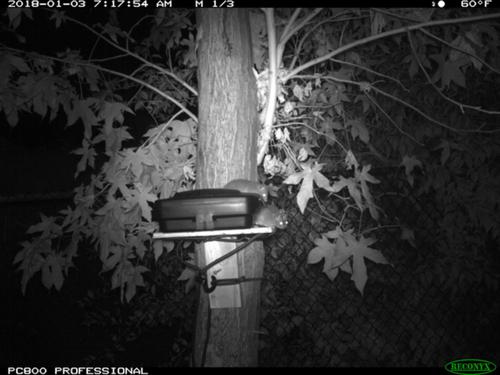当前位置:
X-MOL 学术
›
Pest Manag. Sci.
›
论文详情
Our official English website, www.x-mol.net, welcomes your
feedback! (Note: you will need to create a separate account there.)
Use of rodenticide bait stations by commensal rodents at the urban–wildland interface: Insights for management to reduce nontarget exposure
Pest Management Science ( IF 3.8 ) Pub Date : 2021-02-26 , DOI: 10.1002/ps.6345 Christopher B. Burke 1 , Niamh M. Quinn 2 , Paul Stapp 1
Pest Management Science ( IF 3.8 ) Pub Date : 2021-02-26 , DOI: 10.1002/ps.6345 Christopher B. Burke 1 , Niamh M. Quinn 2 , Paul Stapp 1
Affiliation

|
Pest management professionals use anticoagulant rodenticides, usually placed in tamper-resistant bait stations, to control commensal rodents, but significant concerns remain about exposure of nontarget species, especially at the urban–wildland interface. We deployed digital cameras to monitor use of bait stations placed in 90 residential yards across Orange County, California, USA. Two bait stations, supplied with nontoxic bait, were monitored in each yard for approximately 30 consecutive days during two camera-trapping sessions between December 2017 and March 2019. One station was placed on the ground, while the other was elevated 1–1.5 m to determine if elevating stations could reduce nontarget exposure.
中文翻译:

共生啮齿动物在城市-荒地界面使用杀鼠剂诱饵站:减少非目标暴露的管理见解
害虫管理专业人员使用通常放置在防篡改诱饵站中的抗凝血灭鼠剂来控制共生啮齿动物,但对非目标物种的暴露仍然存在重大担忧,尤其是在城市与荒地的交界处。我们部署了数码相机来监控位于美国加利福尼亚州奥兰治县 90 个住宅区的诱饵站的使用情况。在 2017 年 12 月至 2019 年 3 月期间的两次摄像期间,每个院子里的两个提供无毒诱饵的诱饵站连续监测了大约 30 天。一个站放置在地面上,另一个被抬高 1-1.5 m 至确定升降机是否可以减少非目标暴露。
更新日期:2021-02-26
中文翻译:

共生啮齿动物在城市-荒地界面使用杀鼠剂诱饵站:减少非目标暴露的管理见解
害虫管理专业人员使用通常放置在防篡改诱饵站中的抗凝血灭鼠剂来控制共生啮齿动物,但对非目标物种的暴露仍然存在重大担忧,尤其是在城市与荒地的交界处。我们部署了数码相机来监控位于美国加利福尼亚州奥兰治县 90 个住宅区的诱饵站的使用情况。在 2017 年 12 月至 2019 年 3 月期间的两次摄像期间,每个院子里的两个提供无毒诱饵的诱饵站连续监测了大约 30 天。一个站放置在地面上,另一个被抬高 1-1.5 m 至确定升降机是否可以减少非目标暴露。











































 京公网安备 11010802027423号
京公网安备 11010802027423号